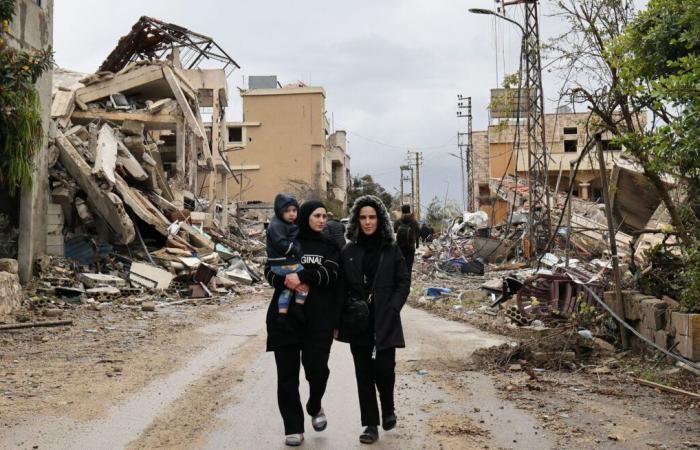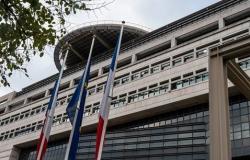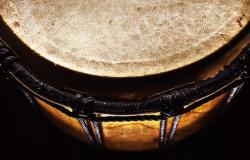
The Lebanese army deploys troops and armored vehicles in the south of the country on Thursday, on the second day of the ceasefire which ended two months of open war between Israel and pro-Iranian Hezbollah, and which it must ensure is maintained. delicate application.
The Lebanese Parliament must meet on January 9 to elect a President of the Republic, of which the country has been deprived for more than two years by the differences between Hezbollah and its adversaries, announced the Lebanese information agency, Ani.
No major hiccups in the truce have so far been reported, despite the rush, as soon as it came into force at 9 a.m. EST on Tuesday, of tens of thousands of residents displaced by the hostilities to return to their homes in the south, the southern suburbs of Beirut and the east of the country, all Hezbollah strongholds shelled for two months by the Israeli air force.
However, two people were injured Thursday in Israeli fire “in the square” of the southern village of Markaba, the Lebanese information agency said. The Israeli army, which warned the population not to approach the positions it still retains, said it had fired in the direction of “suspects (…) arriving with vehicles” in certain areas and “not respecting not the conditions of the ceasefire.”
The Lebanese army “continues its deployment south of the Litani (the river about thirty kilometers from the border, Editor’s note), carries out patrols and installs checkpoints”, a military source told AFP on Thursday, specifying that soldiers do not “advance into areas where the Israeli army is still located.”
In the Christian village of Qlaaya, near the border, Lebanese soldiers were greeted as they entered Wednesday evening by jubilant residents, who threw them flowers and rice, waving Lebanese flags. “We only want the Lebanese army in Lebanon,” chanted the crowd, according to an AFP correspondent.
The army indicated on Wednesday that it was beginning to “strengthen its presence” in the south, “in coordination with the United Nations Interim Force in Lebanon”, UNIFIL.
“Ready to face” Israel
The ceasefire agreement aims to end the deadly conflict that began more than 13 months ago between Israel, the Israeli army and the Lebanese Islamist movement, which has displaced 900,000 people in Lebanon and 60,000 in the north. of Israel.
Sponsored by the United States and France, it provides for the withdrawal within 60 days of the Israeli army from Lebanon, where it entered on September 30, a week after Israel launched a campaign of massive strikes against Hezbollah .
The Lebanese movement must withdraw to the north of the Litani River and dismantle its military infrastructure in the south. The agreement includes American and French technical support for the Lebanese army.
Its mission promises to be delicate: Israel reserves “total freedom of military action” in Lebanon, “if Hezbollah violates the agreement and tries to rearm,” warned its Prime Minister, Benjamin Netanyahu.
Hezbollah, for its part, claimed a “victory” over Israel on Wednesday, affirming that its fighters “will remain fully ready to face […] to attacks by the Israeli enemy.
The Shiite movement will cooperate with the Lebanese state to strengthen the deployment of the army, one of its deputies, Hassan Fadlallah, assured AFP. But its members “are the children of the villages” of the south, from where “no one” can drive them out, he added.
Weakened by Israeli blows, which notably decimated its leadership, the formation, armed and supported by Iran, remains a key player on the Lebanese political scene.
Hezbollah opened a front “in support” of Hamas against Israel at the start of the war in the Gaza Strip, triggered on October 7, 2023 by the unprecedented attack of the Palestinian Islamist movement on Israeli soil. Months of cross-border firefights followed, before the escalation in September.
“Reborn”
The incessant flow of residents returning home to find their devastated towns and villages continues on Thursday, on roads plagued by giant traffic jams, AFP correspondents noted.
In the southern city of Tyre, where smoke still rises from bombed buildings, fishermen wait at the port for a green light from the army to return to sea. “When there was the escalation, we completely stopped working and were threatened by the Israelis,” explains one of them, Madhi Istanbuli.
“Despite the extent of the destruction and our pain, we are happy to have returned,” confides Oum Mohamed Bzeih, a 44-year-old widow who found her house devastated in the village of Zebqine. “We feel reborn. »
According to Lebanese authorities, at least 3,823 people have been killed in the country since October 2023, most since the end of September this year. On the Israeli side, 82 soldiers and 47 civilians died in 13 months, according to the authorities.
In Nahariya, an Israeli coastal town within rocket range of Lebanese territory, Baha Arafat, a 44-year-old man, also expressed his relief on Wednesday. “There is no shelter in the area and the last few days have been tense.”
“There is a feeling of greater security, our children can return to school,” rejoices Yuri, 43, displaced from his kibbutz Yiron, near the border, to Haifa.
But “we do not feel completely reassured”, because “Hezbollah still has strength”, he adds.





